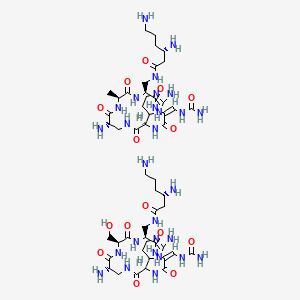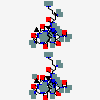Capreomycin
- capreomycin
- Capreomycin (INN)
- CAPREOMYCIN [INN]
- Capostatin
- Capreomicin
- Create:2005-08-01
- Modify:2025-01-11


- Capastat
- Capreomycin
- Capreomycin Sulfate
- Capromycin
Intramuscular therapy with capreomycin has not been definitely linked to liver injury, either in the form of asymptomatic elevations in serum enzymes or of clinically apparent liver injury. However, the agent is rarely used and is always used in combination with other antituberculosis medications, many of which are well known to cause liver injury. Nevertheless, in the few studies done, capreomycin has not been associated with an increase in the rate of serum enzyme elevations or in episodes of acute liver injury above or beyond what was reported in the comparator arm.
Likelihood score: E (unlikely cause of clinically apparent liver injury).
◉ Summary of Use during Lactation
Developmental problems have been reported in two infants exposed to capreomycin in breastmilk; however, their mothers were also exposed to several drugs during pregnancy and during breastfeeding, so the problems cannot necessarily be attributed to capreomycin. Because capreomycin is not orally absorbed it is unlikely to adversely affect the breastfed infant.
◉ Effects in Breastfed Infants
Capreomycin was used as part of multidrug regimens to treat two pregnant women with multidrug-resistant tuberculosis, one throughout pregnancy and postpartum and the other postpartum only. The infants were breastfed (extent and duration not stated). At age 4.6 and 5.1 years, the children were developing normally except for a mild speech delay in one and hyperactivity in the other.
◉ Effects on Lactation and Breastmilk
Relevant published information was not found as of the revision date.
- CAS Common ChemistryLICENSEThe data from CAS Common Chemistry is provided under a CC-BY-NC 4.0 license, unless otherwise stated.https://creativecommons.org/licenses/by-nc/4.0/
- DrugBankLICENSECreative Common's Attribution-NonCommercial 4.0 International License (http://creativecommons.org/licenses/by-nc/4.0/legalcode)https://www.drugbank.ca/legal/terms_of_useCapreomycinhttps://www.drugbank.ca/drugs/DB00314
- Hazardous Substances Data Bank (HSDB)
- ClinicalTrials.govLICENSEThe ClinicalTrials.gov data carry an international copyright outside the United States and its Territories or Possessions. Some ClinicalTrials.gov data may be subject to the copyright of third parties; you should consult these entities for any additional terms of use.https://clinicaltrials.gov/ct2/about-site/terms-conditions#Use
- LiverTox
- NCI Thesaurus (NCIt)LICENSEUnless otherwise indicated, all text within NCI products is free of copyright and may be reused without our permission. Credit the National Cancer Institute as the source.https://www.cancer.gov/policies/copyright-reuseNCI Thesaurushttps://ncit.nci.nih.gov
- Drugs and Lactation Database (LactMed)
- Metabolomics Workbench
- PharmGKBLICENSEPharmGKB data are subject to the Creative Commons Attribution-ShareALike 4.0 license (https://creativecommons.org/licenses/by-sa/4.0/).https://www.pharmgkb.org/page/policies
- Therapeutic Target Database (TTD)
- WHO Anatomical Therapeutic Chemical (ATC) ClassificationLICENSEUse of all or parts of the material requires reference to the WHO Collaborating Centre for Drug Statistics Methodology. Copying and distribution for commercial purposes is not allowed. Changing or manipulating the material is not allowed.https://www.whocc.no/copyright_disclaimer/
- WikipediaUranyl zinc acetatehttps://en.wikipedia.org/wiki/Uranyl_zinc_acetateCapreomycinhttps://en.wikipedia.org/wiki/Capreomycin
- Medical Subject Headings (MeSH)LICENSEWorks produced by the U.S. government are not subject to copyright protection in the United States. Any such works found on National Library of Medicine (NLM) Web sites may be freely used or reproduced without permission in the U.S.https://www.nlm.nih.gov/copyright.htmlCapreomycinhttps://www.ncbi.nlm.nih.gov/mesh/68002207Protein Synthesis Inhibitorshttps://www.ncbi.nlm.nih.gov/mesh/68011500Anti-Bacterial Agentshttps://www.ncbi.nlm.nih.gov/mesh/68000900Antibiotics, Antitubercularhttps://www.ncbi.nlm.nih.gov/mesh/68000904
- PubChem
- NCBI

 CID 135483771
CID 135483771 CID 135483772
CID 135483772